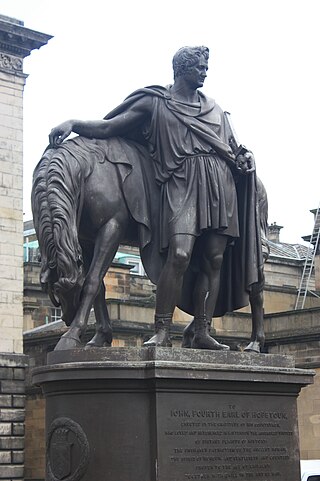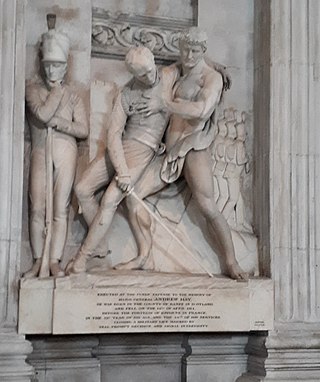Related Research Articles

The Dean Cemetery is a historically important Victorian cemetery north of the Dean Village, west of Edinburgh city centre, in Scotland. It lies between Queensferry Road and the Water of Leith, bounded on its east side by Dean Path and on its west by the Dean Gallery. A 20th-century extension lies detached from the main cemetery to the north of Ravelston Terrace. The main cemetery is accessible through the main gate on its east side, through a "grace and favour" access door from the grounds of Dean Gallery and from Ravelston Terrace. The modern extension is only accessible at the junction of Dean Path and Queensferry Road.

Earl of Chesterfield, in the County of Derby, was a title in the Peerage of England. It was created in 1628 for Philip Stanhope, 1st Baron Stanhope. He had been created Baron Stanhope, of Shelford in the County of Nottingham, in 1616, also in the Peerage of England. Stanhope's youngest son, the Hon. Alexander Stanhope, was the father of James Stanhope, 1st Earl Stanhope, while his half-brother Sir John Stanhope of Elvaston was the great-grandfather of William Stanhope, 1st Earl of Harrington.

Earl of Huntingdon is a title which has been created several times in the Peerage of England. The medieval title was associated with the ruling house of Scotland.

William Behnes was a British sculptor of the early 19th century.

The Smith, later Bromley, later Pauncefote-Bromley, later Bromley-Wilson, later Bromley Baronetcy, of East Stoke in the County of Nottingham, is a title in the Baronetage of Great Britain. It was created on 31 October 1757 for the banker George Smith, High Sheriff of Nottinghamshire from 1757 to 1759. He was the eldest son of Abel Smith I (1686–1756) of Nottingham, the 2nd son of Thomas Smith I (1631–1699), the founder of Smith's Bank in Nottingham. His younger brothers included: Abel Smith II (1717–1788) and John Smith, ancestor of Julian Pauncefote, 1st Baron Pauncefote.
Sir Montague Cholmeley, 1st Baronet was a British politician and baronet.
Honouring individuals buried in Westminster Abbey has a long tradition.

John Savile, 2nd Earl of Mexborough, styled Viscount Pollington between 1766 and 1778, was a British peer and politician.

Edward Michael Pakenham, 2nd Baron Longford was an Anglo-Irish naval officer, peer and landowner.
John Bacon (1777–1859), also known as John Bacon the Younger, or Junior, to distinguish him from his equally famous father, was an English sculptor.

William Stanton (1639–1705) was an English mason and sculptor. He is known particularly for monumental masonry. He is often ferred to as Stanton of Holborn.
This father and son from York, England were sculptors through the 18th century and into the 19th century. John Fisher the elder lived 1736-1804, whilst John Fisher the younger is thought to be born around 1760 and died in 1839. Their work is well represented in York Minster and in other Yorkshire towns.
Sir John Savile (1546–1607) was an English lawyer and judge.

Thomas Campbell was a Scottish sculptor in the early 19th century. He has several important public works, most notably a statue of Sarah Siddons in Westminster Abbey. He also has several works in the National Gallery in London. He was heavily patronised by the British aristocracy, as evidenced by his works.

St Andrew and St Mary's Church is a Grade I listed Church of England parish church dedicated to Saint Andrew and Saint Mary, in the parish of Easton and the village of Stoke Rochford, Lincolnshire, England. The church is 5 miles (8 km) south from Grantham, and at the western side of the Lincolnshire Vales in South Kesteven.

Humphrey Hopper (1767–1844) was an English sculptor and stonemason. He was given the government commission for the memorial in St Paul's Cathedral to General Andrew Hay.
Sarah Greville, Countess of Warwick, formerly Lady Monson, was the wife of Henry Greville, 3rd Earl of Warwick.

Charles Harriott Smith (1792–1864) was an English architect and architectural sculptor involved in several prestigious projects, ranging from the National Gallery to the Houses of Parliament. His iconic works include the capital of Nelson's Column supporting the statue by Edward Hodges Baily.
Joseph Theakston was a 19th-century British sculptor mainly working in the Hellenistic style.
Charles Raymond Smith (1798–1888) was a 19th-century British sculptor.
References
- ↑ "Robert Blore, Sr and Jr - Bob Speel's website".
- ↑ Dictionary Of British Sculptors 1660-1851 by Rupert Gunnis
- ↑ http://www.our civilisation.com/smartboard/shop/anecdtes/c19/wilson.htm
- ↑ Persuasion and Propaganda: Monuments and the 18th century British Empire by Joan Coutu
- ↑ "Elizabeth, Countess of Mexborough".